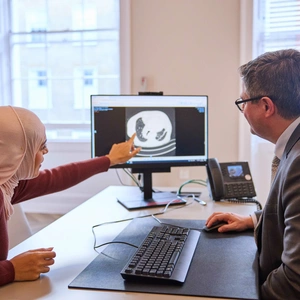Pulmonary fibrosis
Pulmonary fibrosis (PF) affects millions of people worldwide, with idiopathic pulmonary fibrosis (IPF) being the most common type. Although we can’t reverse pulmonary fibrosis, our expert-led team of respiratory specialists offers bespoke management plans to help you find relief from your symptoms.
What is pulmonary fibrosis?
Pulmonary fibrosis is a group of chronic lung diseases caused by progressive scarring of the lung tissue. It also impacts the connecting tissue in your lungs and the air sacs (alveoli) inside them.
As the scar tissue thickens and stiffens, your lungs can’t expand as well as they should, making it harder for you to breathe. You may tire out much easier, even during everyday tasks.
While there is no cure, we offer various treatments that can slow disease progression and keep your symptoms under control.
There are many types of pulmonary fibrosis, including:
- Asbestosis (an asbestos-related lung disease)
- Drug-induced pulmonary fibrosis
- Hypersensitivity pneumonitis
- Idiopathic pulmonary fibrosis
- Idiopathic non-specific interstitial pneumonia
- Pneumoconiosis
- Rheumatoid arthritis interstitial lung disease
- Sarcoidosis
- Silicosis
- Systemic sclerosis
The type of pulmonary fibrosis you have can help us determine the right treatment options for you.
Pulmonary fibrosis symptoms
Pulmonary fibrosis can cause different symptoms in different people. However, common pulmonary fibrosis symptoms include:
- Shortness of breath
- A persistent, dry cough
- Fatigue
- Unexplained weight loss
- Breathing in short, shallow breaths
- Chest discomfort
As pulmonary fibrosis progresses and becomes more severe, some people develop clubbing (swelling) of their fingertips and toes and cyanosis (where your skin is tinged blue or grey).
Pulmonary fibrosis diagnosis
To diagnose pulmonary fibrosis, we’ll first ask about your symptoms, medical history and potential exposure to harmful substances. Then, we’ll perform a physical exam, listening to your chest and checking for abnormalities, such as crackling sounds when you breathe.
Diagnostic imaging tests are usually the next step, as they can reveal lung scarring in more detail.
Imaging tests we may perform are:
If imaging tests have not shown any scarring, we may also collect a lung biopsy (tissue sample) to confirm the condition.
Lung function tests play an important role in diagnosing pulmonary fibrosis because they measure your lung capacity and oxygen exchange capacity to see how much pulmonary fibrosis is affecting your lungs. We’ll also check your oxygen levels to see how well your lungs work.
Sometimes, we may perform blood tests to check for underlying autoimmune diseases that may have led to pulmonary fibrosis.
Pulmonary fibrosis treatment
Pulmonary fibrosis is a chronic, progressive condition that has no cure. But we offer bespoke management plans based on your needs to help alleviate symptoms and slow disease progression.
Some of the treatments we may offer you for pulmonary fibrosis include:
- Antifibrotic medications – to slow the progression of scarring in the lungs
- Oxygen therapy – helps to maintain healthy oxygen levels and reduce breathlessness and fatigue
- Pulmonary rehabilitation – we help you learn how to breathe better and exercise while having pulmonary fibrosis to support your wellbeing
- Managing underlying health conditions – if we find a link between your pulmonary fibrosis and underlying health conditions, getting these under control is essential to slow disease progression
We may advise you to receive annual flu and pneumococcal vaccinations to protect your respiratory health. Lifestyle modifications like quitting smoking and protecting your respiratory health from irritants and pollutants can also help.
In severe cases, if no other treatments are effective and your quality of life is greatly affected, we may suggest a lung transplant.
Symptom management is also vital in pulmonary fibrosis palliative care through dedicated medications and emotional support.
Our team can offer the supportive care you need when facing this challenging disease. We’ll provide personalised management plans and advice to help you find relief from your symptoms.
Frequently asked questions (FAQs)
Pulmonary fibrosis isn’t always preventable. However, you can do some things to minimise your risk, such as:
- Quitting smoking
- Avoiding harmful chemicals and substances
- Staying fit and active
The success of your treatment will depend on various factors, like how advanced your condition is and your overall health. Pulmonary fibrosis cannot be reversed or cured, but we can help you find relief from your symptoms through personalised management plans.



